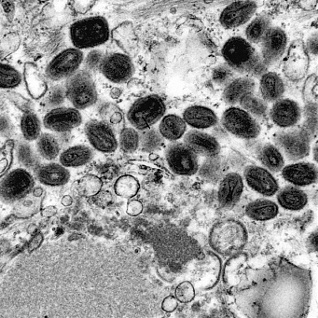POXVIRIDAE
Enveloped, linear, dsDNA
The most complex and largest animal viruses known and have some characteristics that approach those of primitive cells.
Like all viruses pox viruses can not metabolize and depend on host cells for protein synthesis.
Poxviruses are UNIQUE in that they are DNA viruses that replicate in the cytoplasm.
A host cell infected with a poxvirus exhibits DNA synthesis outside the nucleus, something that otherwise occurs only in intracellular organelles such as mitochondria.
Size and Morphology
Poxviruses are complex in structure.
The poxviruses are very large in size (400 nm or 0.4 µm long).
Can be seen under the light microscope.

lb = lateral bodies; c = core
The vaccinia virion (close to the small poxvirus) is a brick-shaped structure about 400 x 240 x 200 nm in size.
The virion is covered on its outer surface with tubules or filaments arranged in a membrane-like pattern.
It does not have a lipid membrane because the outer envelope consists of protein.
Within the virion there are two lateral bodies of unknown composition and a core (nucleocapsid) which contains DNA bounded by a layer of protein subunits.

Smallpox virus

Human tissue infected with variola major (smallpox)
Genome
The genome consists of linear, ds DNA.
Have the largest genome of all viruses.
The vaccinia virus genome has about 185 kb pairs and contains between 150 to 200 genes.
Its DNA is interesting because the two strands of the double helix are cross-linked at the ends as a result of the formation of phospho-diester bonds between adjacent strands.
Replication of Poxviruses
Vaccinia virions are taken up into cells via a phagocytic process from which the cores are liberated into the cytoplasm.
Multiply in well-defined sites called factory areas, which appear as inclusion bodies in cytoplasm of infected cells.
Uncoating of the virus genome requires the action of a new protein that is synthesized after infection.
This protein is encoded by viral DNA, and the gene specifying this protein is transcribed by an RNAP present within the virus particle.

Source: Flint et al. 2000. Principles of Virology.

Source: J.H. & E.G. Strauss.2008. Viruses and human disease. p. 266
In addition to this uncoating gene, a number of other viral genes are transcribed.
The primary transcripts are turned into mRNAs by capping and polyadenylation while they are still inside the virus core.
Once the vaccinia DNA is fully uncoated, the formation of inclusion bodies within the cytoplasm begins.
Within these inclusion bodies, transcription, replication, and encapsidation into progeny virus particles occur.
Each infecting virion initiates its own inclusion body, so the number of inclusions depends on the multiplicity of infection (MOI).
Progeny DNA molecules form a pool from which individual molecules are incorporated into virions.
Mature virions accumulate in the cytoplasm.
There seems to be no specific release mechanism, and most virions are released only when the infected cell disintegrates.
Diseases Caused by Poxviruses
Have been important medically as well as historically.
Produce eruptive skin pustules called pocks or pox, which leave small, depressed scars upon healing.
Produce the typical lesions and also tend to stimulate cell growth that can lead to tumor formation (generally benign).
Smallpox
Two forms: variola major and variola minor.
First virus for which a vaccine was developed by Edward Jenner in 1798.
Transmits by inhalation of droplets or skin crusts.
Even recently as 1967, 10 to 15 million cases occurred worldwide, with thousands of fatalities.
By the application of this vaccine on a worldwide basis, smallpox was eradicated in the early 80's.
The main reasons for success are that only humans with active cases of smallpox are infectious and variola is not a latent virus nor is it harbored by healthy carriers.
People who survived any form of smallpox nearly always developed lifelong immunity.
Virus isolated by inoculating the chorioallantoic membrane of chicken eggs with specimen and pocks are then observed.

Poxviruses and Recombinant Vaccines
Vaccinia virus has been used as a host for genetically altered proteins of other viruses, permitting construction of genetically-engineered vaccines.
Vaccinia virus causes no serious health effects in humans but is highly immunogenic.
Molecular cloning methods have been used to express key viral proteins of influenza virus, rabies virus, Herpes simplex virus type I, and hepatitis B virus in vaccinia virus virions, and on the latter develop a vaccine.
A similar vaccine delivery system using Adenovirus as a vehicle has been developed because, like vaccinia, adenoviruses are of little health consequence to humans.
Molluscum contagiosum
Virus particles have a typical Poxvirus structure with prominent surfuce tubules.
Viruses fill the cytoplasm of infected epithelial cells, causing a prominent mass called a molluscum body.
Transmitted by direct contact and fomites.
Mostly found in the Pacific islands.
Frequent in sports people: wrestlers and by the sharing of towels.
An STD common in sexually active young people.
The skin eruption takes the form of small, waxy papules in the genital region.
This virus has not yet been cultivated under laboratory conditions.

Molluscum contagiousum poxvirus
Poxviruses in Animals
Many mammalian groups host some sort of Poxvirus infection.
Bovine cowpox (affects cats also)
Rabbitpox (rabbit myxomatosis virus)
Monkeypox (reservoir is the squirrel not the monkey)
Mousepox
Chickenpox is a herpesvirus and not a poxvirus!
Only monkeypox and cowpox appear to be capable of infecting humans symptomatically.
Many cases of monkeypox affect children in western Africa.
Now many are vaccinated.
Cowpox is an eruptive cutaneous disease that can develop on cow's udders and teats, but cows are not the actual reservoir.
Human infection by cowpox is rare and usually confined to the hands and sometimes other cutaneous parts of the body.
Poxviruses in Insects
Entomopoxvirus A, B and C